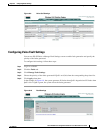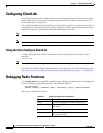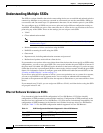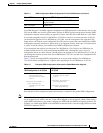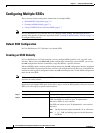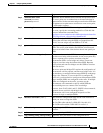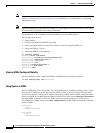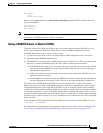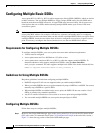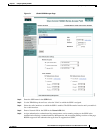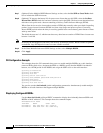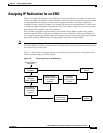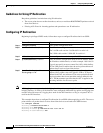
7-5
Cisco IOS Software Configuration Guide for Cisco Aironet Access Points
OL-29225-01
Chapter 7 Configuring Multiple SSIDs
Configuring Multiple SSIDs
Step 3
authentication client
username username
password password
(Optional) Set an authentication username and password that
the access point uses to authenticate to the network when in
repeater mode. Set the username and password on the SSID that
the repeater access point uses to associate to a root access point,
or with another repeater.
Step 4
accounting list-name (Optional) Enable RADIUS accounting for this SSID. For
list-name, specify the accounting method list. Click this link
for more information on method lists:
http://www.cisco.com/univercd/cc/td/doc/product/software/ios
122/122cgcr/fsecur_c/fsaaa/scfacct.htm#xtocid2
Step 5
vlan vlan-id (Optional) Assign the SSID to a VLAN on your network. Client
devices that associate using the SSID are grouped into this
VLAN. You can assign only one SSID to a VLAN.
Step 6
guest-mode (Optional) Designate the SSID as your access point guest-mode
SSID. The access point includes the SSID in its beacon and
allows associations from client devices that do not specify an
SSID.
Step 7
infrastructure-ssid [optional] This command controls the SSID that access points and bridges
use when associating with one another. A root access point only
allows a repeater access point to associate using the
infrastructure SSID. A root bridge only allows a non-root
bridge to associate using the infrastructure SSID. Repeater
access points and non-root bridges use this SSID to associate
with root devices.
The access point and bridge GUI requires the configuration of
infrastructure-ssid for repeater, and non-root bridge roles. It is
not mandatory to configure infrastructure SSID for workgroup
bridge roles. However, if you use the CLI to configure the
device role, you do not have to configure an infrastructure SSID
unless multiple SSIDs are configured on the radio. If multiple
SSIDs are configured on the radio, you must use the
infrastructure-ssid command to specify which SSID the
non-root bridge uses to connect to the root bridge.
However, from 12.4(21a)JA1 and 12.3(8)JEC release onwards,
repeaters do not associate with bridges when
infrastructure-ssid is not configured irrespective of the
presence of single or multiple SSIDs.
Step 8
interface dot11radio { 0 | 1 } Enter interface configuration mode for the radio interface to
which you want to assign the SSID.
The 2.4-GHz radio and the 2.4-GHz 802.11n radio is 0.
The 5-GHz radio and the 5-GHz 802.11n radio is 1.
Step 9
ssid ssid-string Assign the global SSID that you created in Step 2 to the radio
interface.
Step 10
end Return to privileged EXEC mode.
Step 11
copy running-config startup-config (Optional) Save your entries in the configuration file.
Command Purpose



